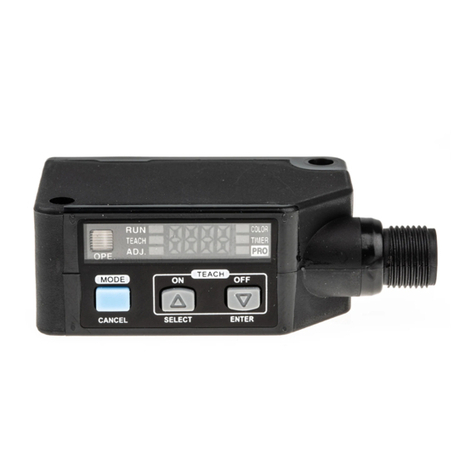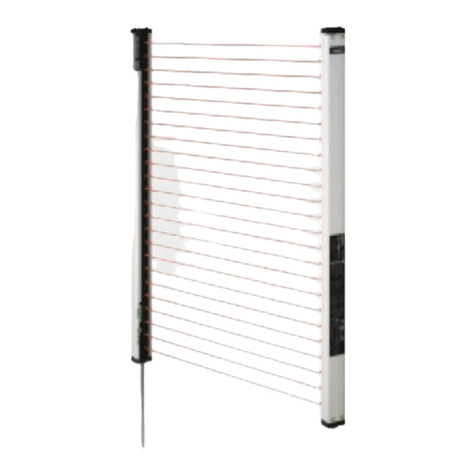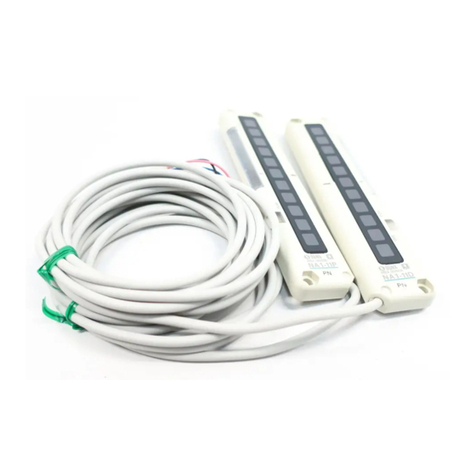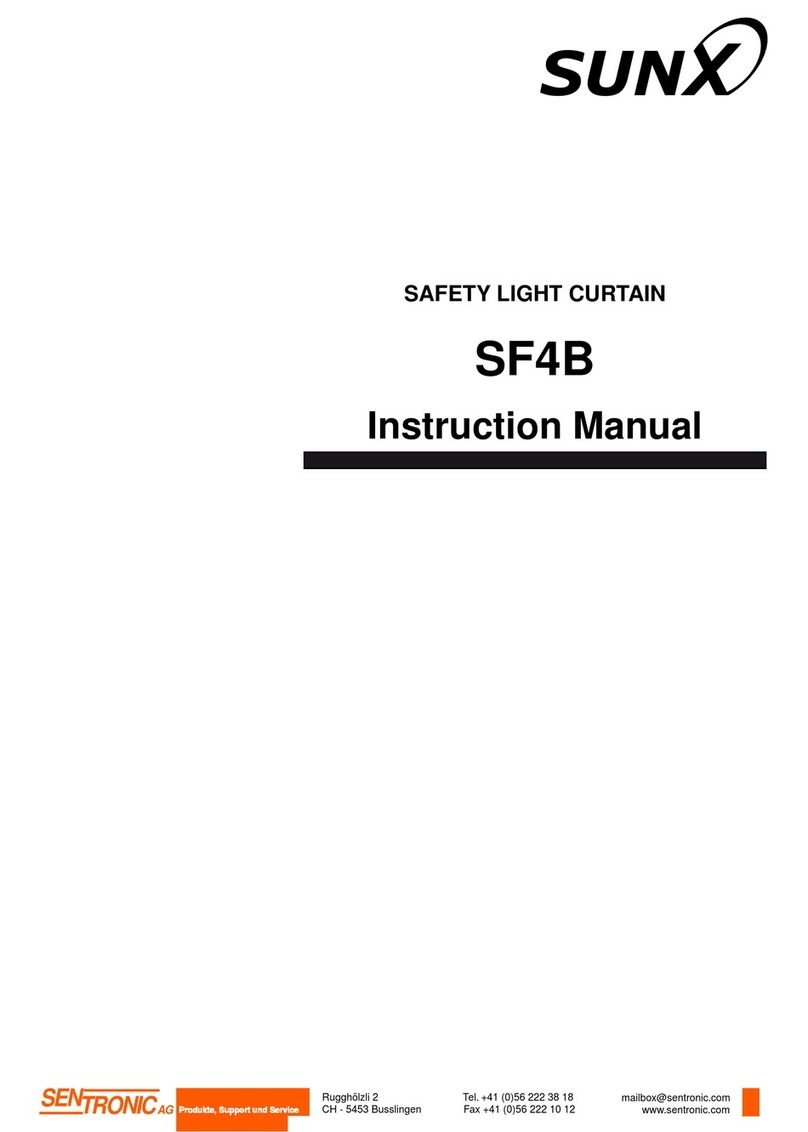
bCASCADING AMPLIFIERS
䢇Make sure to add or remove the amplifiers in the power supply off condition.
䢇Make sure to check the allowable ambient temperature, as it depends on the
number of amplifiers connected in cascade.
䢇In case two, or more, amplifiers are connected in cascade, make sure to mount
them on a DIN rail.
䢇When connecting in cascade, mount the amplifiers close to each other, fitting
them between the optional end plates (MS-DIN-E) mounted at the two ends.
䢇
Up to maximum 15 amplifiers can be added (total 16 amplifiers connected in cascade.)
䢇When connecting more than two amplifiers in cascade, use the sub cable
(CN-71-
C
M
)
as the quick-connection cable for the second amplifier onwards.
䢇Since the model setting gets changed if collective teaching is done for the ampli-
fiers in Leak setting (F7 mode) and in Liquid setting (F9 mode) mounted in cas-
cade, note that collective teaching should not be done for amplifiers with different
model settings mounted in cascade.
䢇Since the communication function of this sensor and that of the digital fiber sen-
sor FX-301(P)/311(P) is different, if these models are mounted in cascade, do
not use the communication function.
䢇In case of cascading, wait for 10 minutes, or more, to use the teaching function
after the power is switched on.
qMount the amplifiers, one by one, on the
35mm width DIN rail.
(For details, refer to cMOUNTING.)
wSlide the amplifiers next to each other,
and connect the quick-connection cables.
eMount the optional end plates
(MS-DIN-E) at both the ends to hold the
amplifiers between their flat sides.
rTighten the screws to fix the end plates
(MS-DIN-E).
Cascading method
qLoosen the screws of the end plates
(MS-DIN-E).
wRemove the end plates (MS-DIN-E).
eSlide the amplifiers and remove them one
by one.
(For details, refer to cMOUNTING.)
Slide
Slide
35mm width
DIN rail
End plates
(MS-DIN-E)
(optional)
Sub cable
(CN-71-CM)
(optional)
Main cable
(CN-73-CM) (optional)
Dismantling method
nI/O CIRCUIT DIAGRAMS
䢇FX-301-F / NPN output type
D
Tr 100mA max. (Note 2)
11
2
3
3
2
Z
D
Terminal No.
+
V
Output
0V
Color code of quick-connection cable
(Brown)
+
V (Note 1)
(Black) Output
(Blue) 0V (Note 1)
Users’circuitInternal circuit
Load +
–
12 to 24V DC
±10%
Sensor circuit
Notes: 1) The quick-connection sub cable does not have +V (brown) and 0V (blue).The power is
supplied from the connector of the main cable.
2) 50mA max. if five, or more, amplifiers are connected together.
3) Do not use the amplifiers in a series (AND) connection.
Notes: 1) The quick-connection sub cable does not have +V (brown) and 0V (blue).The power is
supplied from the connector of the main cable.
2) 50mA max. if five, or more, amplifiers are connected together.
3) Do not use the amplifiers in a series (AND) connection.
mPART DESCRIPTION
1
2
3
1
3
2
100mA max. (Note 2)
Terminal No.
+V
Output
0V
Color code of quick-connection cable
(Brown) +V (Note 1)
(Black) Output
(Blue) 0V (Note 1)
Users’circuitInternal circuit
+
–
12 to 24V DC
±10%
D
Tr Z
D
Load
Sensor circuit
䢇FX-301P-F / PNP output type
,OPERATION PROCEDURE
䢇When the power supply is switched on, normal condition is displayed [MODE indi-
cator / RUN (green) lights up] and the digital display shows the incident light inten-
sity.
䢇When MODE key is pressed, the mode changes as per the diagram below. Fur-
ther, if the jog switch is pressed for 3 sec., or more, in ‘ADJ’, ‘DISP’or ‘OUT’con-
dition, SUB mode can be set.
Refer to
.RUN MODE.
Refer to ⁄4 FORCED
OUTPUT MODE.
RUN TEACH ALL
OUT
Refer to ⁄7 NO/NC
SELECTION FUNCTION.
Note 1: In Liquid setting (F9 mode) only.
.RUN MODE
䢇When MODE indicator / RUN (green) lights up, the display setting or the sensitiv-
ity select setting can be checked. Refer to ⁄5 SENSITIVITY SELECTION FUNC-
TION for further details of sensitivity select setting.
䢇When cJog switch is pressed for 2 sec., or more, the display changes as per the
diagram below.
How to change to ‘percent display’
䢇If xJog switch is turned to ‘+’or ‘–’side, the present sensitivity state can be
confirmed. After 2 sec., the display returns to ‘digit display’or ‘percent display’.
How to check the sensitivity state
⁄0 INDIVIDUALTEACHING MODE
Press
zMODE
DISP
Refer to
⁄0
INDIVIDUAL
TEACHING MODE.
Refer to
⁄1
COLLECTIVE
TEACHING MODE.
Refer to
⁄6 TIMER FUNCTION.
Refer to
⁄3
DIGITAL DISPLAY
SETTING MODE.
ADJ
Refer to ⁄5 SENSITIVITY
SELECTION FUNCTION.
Refer to
⁄2
THRESHOLD LEVEL
FINE ADJUSTMENT MODE.
MAIN
mode
SUB
mode
Press cJog switch
for 3 sec., or more.
(Note 1)
Press cJog switch
for 2 sec., or more.
Or
䢇
When MODE indicator /TEACH (yellow) lights up, threshold value can be set on a single unit.
Notes: 1)For details, refer to ⁄8 ERROR INDICATION.
2)The initial setting at the time of factory shipment is Liquid (F9) mode (
-F9-
).
Step Description
MODE key Press Used for mode selection or cancellation during setting.
(Note 2)
Turn Used to select each item.
Press Used to enter each item.
Jog switch
MODE indicator / ADJ (Yellow)
MODE indicator / DISP (Yellow)
MODE key
Jog switch
MODE indicator /
OUT (Yellow)
Digital display (Red)
MODE indicator / ALL (Yellow)
MODE indicator / TEACH (Yellow)
MODE indicator / RUN (Green)
Output operation
indicator (Orange) Model indicator
(Green)
Note 2:When zMODE key is pressed for 1 sec., or more, the sensor returns to the RUN mode.(in
MAIN mode only)
Symbols... D : Reverse supply polarity protection diode
ZD: Surge absorption zener diode
Tr : NPN output transistor
Symbols... D : Reverse supply polarity protection diode
ZD: Surge absorption zener diode
Tr : PNP output transistor
Terminal
arrangement
diagram
Terminal
arrangement
diagram
Press
zMODE
Press
zMODE Press
zMODE
Press
zMODE Press
zMODE
Press cJog switch
for 3 sec., or more.
(Note 1)
Press
c
Jog switch
for 3 sec., or more.
The incident light intensity is dis-
played within the range 0 to 4,000. The incident light intensity is displayed in
percentage (within 0 to 999) based on the
threshold value as the reference.
Lo
Operating in the low sensitivity mode.
<LO mode>
HI
Operating in the high sensitivity mode.
<HI mode>
The sensitivity selection function is set to the automatic sensitivity setting (
Auto
)
at the time of factory shipment. In case sensitivity selection setting is done,
make sure to carry out ‘teaching’after the sensitivity selection setting.
For the sensitivity selection setting, refer to ⁄5
SENSITIVITY SELECTION FUNCTION
.
<Percent display>
123P
<Digit display>
1234
q
w
e
t
Step Display Description
•Insert Leak detection fiber (FD-F7M) or Liquid detection fiber
(FT-F9M).
•Press zMODE key to light up MODE indicator /TEACH (yellow).
r
•Turn xthe jog switch to ‘+’or ‘–’side to set to either Leak (F7)
mode (
-F7-
) or Liquid (F9) mode (
-F9-
).
•In case Liquid (F9) mode (
-F9-
) is set, the model indicator (Green)
lights up.
•Press cJog switch in no-leak condition with Leak detection fiber
(FD-F7M) or no-liquid condition with Liquid detection fiber (FT-F9M).
Then, ‘
1
’on the display moves from left to right.
•When teaching is accepted, the result of threshold value setting is
displayed.
In case stable sensing is possible:‘
9ood
’on the display blinks
three times.
In case stable sensing is not possible:‘
Er-3
' on the display blinks.
(Note 1)
•
If the teaching result is‘
9ood
’, the sensor returns to RUN mode au-
tomatically and the incident light intensity is shown on the display.
•MODE indicator / RUN (green) lights up.
•The setting is complete.
1234
-F7-
-F9-
1
9ood
Er-3
1234

























